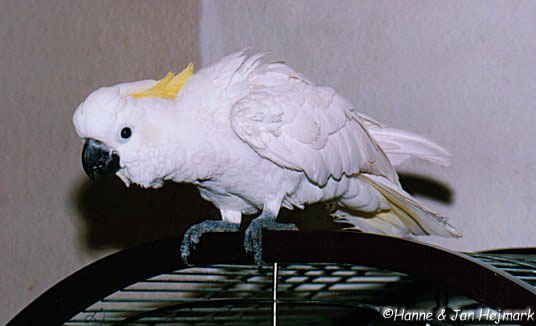Cacatua galerita - Sulphur-crested Cockatoo
Cacatua galerita eleonora
Photo: Copyright © by Izabella Bodin
Sulphur-crested Cockatoo – Cacatua galerita (Latham, 1790) – is a large white cockatoo with a yellow crest.
They are very curious, intelligent and social birds, which makes them very popular as pets. However, they they require a lot of training and attention, otherwise they may develop mental issues like picking their feathers or scream very loud to attract attention!
Make sure to provide plenty of bird-safe toys as they love to chew on wood and other hard materials. Also make sure the aviary is build from strong materials; they have been reported to chew on soft timber on buildings and outdoor furniture!
Wild birds have a lifespan of 20-40 years but pet birds can be much older – some birds are reported having a lifespan of more than 75 years.
Make sure to quarantine new birds as they are susceptible to Psittacine Beak and Feather Disease (PBFD).
Sulphur-crested Cockatoo is listed on CITES Appendix II and EU Annex B.
Description
The overall plumage is white with a yellowish color under the wing and tail. The large crest is bright yellow and curves up when not raised or forward when raised. The bill is slate grey; the legs are grey.
The nominate form has a white eye-ring and pale yellow ear coverts; the bases of feathers of cheeks and throat are also pale yellow.
Size: 44-55 cm – the Australian subspecies larger than the other subspecies.
Weight: 815-975 gram
Males have black eyes; the females have a reddish dark brown eye.
Juveniles are similar to the adults but with brown eyes and a pale greyish tint on some of the plumage.
Sulphur-crested Cockatoo look similar to the Yellow-crested Cockatoo (Cacatua sulphurea), but the Yellow-crested Cockatoo is smaller, has a darker blue eye-ring and the crest has a different shape.
Subspecies
Four subspecies are recognized:
- Cacatua galerita galerita (Latham, 1790) : This is the largest subspecies. It has a yellow patch on the ears and yellow base on the feathers on cheeks and throat. The eye-ring is white.
- Cacatua galerita eleonora (Finsch, 1863) : Similar to C. g. galerita but smaller and with blueish eye-ring; the yellow spot on the ear is missing or only very faint. The feathers in the crest is broader.
- Cacatua galerita fitzroyi (Mathews, 1912) : Similar to C. g. eleonora but larger and the crest is not as broad.
- Cacatua galerita triton (Temminck, 1849) : Similar to C. g. eleonora but the beak is smaller.
Habitat
Four subspecies are recognized:
- Cacatua galerita galerita : Eastern and southeastern Australia from Cape York to Adelaide and also on King Island and Tasmania.
- Cacatua galerita eleonora (Finsch, 1863) : Endemic to Aru Islands in the Maluku province of eastern Indonesia.
- Cacatua galerita fitzroyi (Mathews, 1912) : Northern Australia from Fitzroy River to Gulf of Carpenteria.
- Cacatua galerita triton (Temminck, 1849) : New Guinea and nearby islands
Cacatua galerita eleonora
Photo: Copyright © by Hanne & Jan Højmark
Diet
The main diet should be based on pellets. Add a good mix of seeds and nuts as supplement and various vegetables and fruits.
When the flock seek food on the ground, at least one bird will stay in the threes to watch out for predators.
Aviculture
Wild birds nests in a hollow tree using a bed of wood chips.
A vertical box with the measurement of approx. 40 x 40 x 90 cm is recommended as nest box. The aviary should be at least 4,5 meters long.
The clutch contains 2-3 eggs; incubation time is 25-27 days. Both parents incubates the eggs and care for the juveniles. The chicks fledges after 9-12 weeks but still stay with their parents a few months after leaving the nest.
Taxonomy
- Order: Psittaciformes
- Family: Cacatuidae
- Genus: Cacatua
Synonyms
- Danish: Stor Gultoppet Kakadu
- English: Sulphur-crested Cockatoo, Greater Sulphur-crested Cockatoo
- French: Cacatoès à huppe jaune, Grand Cacatoès à huppe jaune
- German: Gelbhaubenkakadu
- Portuguese: Cacatua-de-crista-amarela
- Spanish: Cacatúa de Moño Amarillo, Cacatúa Galerita
- Scientific: Cacatua galerita
IUCN Red List

https://dx.doi.org/10.2305/IUCN.UK.2018-2.RLTS.T22684781A131914971.en
Downloaded on 9 July 2021
Cacatua galerita triton
Cacatua galerita triton




